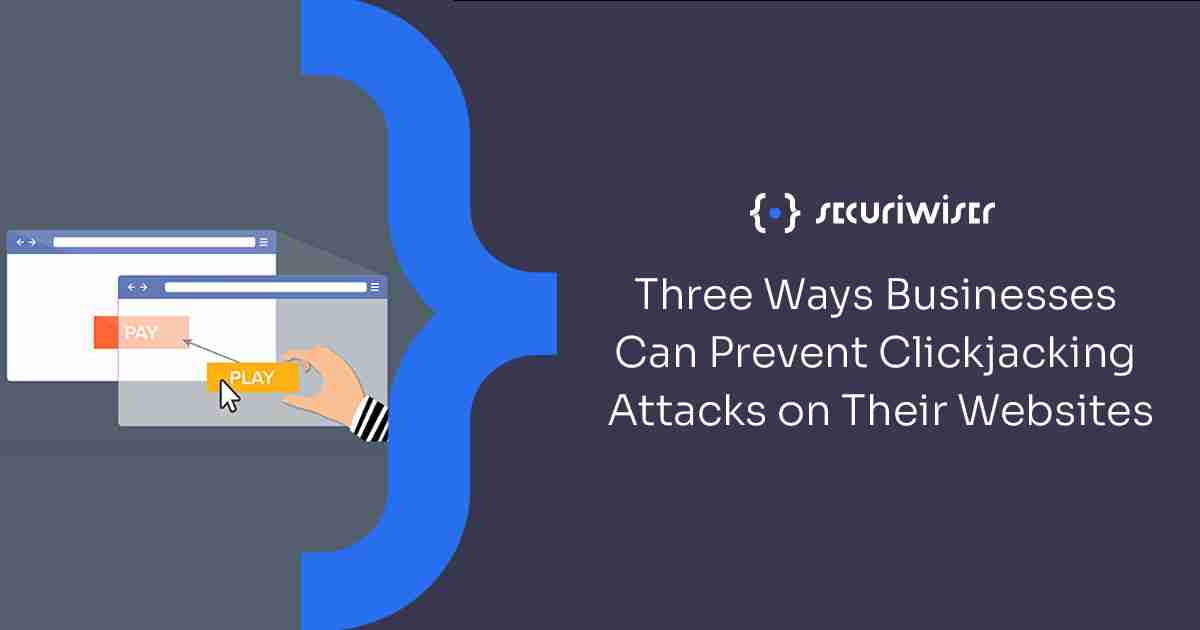Three Ways Businesses Can Prevent Clickjacking Attacks on Their Websites
Blog / Three Ways Businesses Can Prevent Clickjacking Attacks on Their Websites
3 MIN READ

Clickjacking occurs when malicious actors use transparent layers somewhere on the screen with the intention of tricking users into performing an unintended action.
Attackers insert invisible user interface layers on top of the actual page, often with the aim of convincing users they are interacting with legitimate parts of the page they are on. In reality, threat actors are trying to steal login credentials and other information, or indirectly do so through installing harmful programs onto your device, such as spyware or malware.
By exploiting different parts of a page on the internet, a user may be led to believe they are inputting data on the actual site, whereas, in reality, they are giving all their details to attackers, likely hosting the input boxes or pages on their own server.
An example of this in action could be a clickjacking attack on the payment page of an e-commerce site. Whilst the user believes they are inputting their banking details onto the actual site, they are, unintentionally, sending their information to an attacker, who has installed an invisible layer on top of the website page.
Another example of clickjacking would be an attacker exploiting easy access ordering online. They may line-up perfectly an additional layer on top of a screen that tricks a user into clicking on a button that authenticates 1-click ordering. This could be anything, such as a button to play a video, or a button which supposedly closes a pop-up. The intention is to ‘hijack’ clicks for a malicious purpose.
How to prevent clickjacking attacks on your website
Suffering from clickjacking attacks is an unwanted situation for businesses to be in. Your website, and company as whole, can lose credibility when users are scammed whilst using your site, or have harmful programs downloaded onto their devices.
Your website can become compromised if you do not have the appropriate security measures in place. Here are three server-side methods in which you can reduce the likelihood of suffering clickjacking attacks.
- X-Frame-Options – the x-frame header specifies whether a browser is permitted to embed your web pages in a frame. The header declares its preferred framing policy, and the website owner can alter this. By setting the X-Frame-Options to either DENY or SAMEORIGIN, any framing, or framing by external sites, will be prevented.[Text Wrapping Break][Text Wrapping Break]Clickjacking attacks that utilise frames can be stopped in this way. However, the X-Frame-Options header will soon become obsolete due to the W3C’s Content Security Policy Level 2 Recommendation that an alternative security directive, frame-ancestors, should be used instead.
- Content Security Policy (CSP) frame-ancestors – the CSP frame-ancestors directive is highly effective against webpage embedding. It can allow or disallow embedding of content by potentially hostile pages using iframes, objects or other mechanisms. The CSP is an important cybersecurity consideration for implementation as it can also protect your website from cross-site scripting, an extremely common type of attack.
Once implemented, the CSP frame-ancestors response headers can be set to disallow embedding. To enable embedding by your domain only, frame-ancestors should be set to ‘self’. To prevent embedding by all domains, the header should instead be set to ‘none’.
This directive obsoletes X-Frame-Options. If a page has both headers, the frame-ancestors header should be preferred by the browser.
- Framekiller – website owners can offer an element of server-side protection by utilising a framekiller JavaScript snippet in pages they do not want to be included inside frames from different sources.[Text Wrapping Break][Text Wrapping Break]However, JavaScript-based protection is not always reliable, and can sometimes be circumvented. Therefore, the best option is to adopt the CSP frame-ancestors directive.
How Securiwiser can help
With Securiwiser, your domains can be monitored to reveal cybersecurity vulnerabilities. Both the presence of a Content security policy (CSP) and whether a website is implementing X-Frame-Options best practices are checked with their simple, automated cybersecurity monitoring service. Designed for SMEs Securiwiser is the new affordable cybersecurity monitoring tool on the market. Try it for free today.
Previous Article
Top Ways To Future-Proof SMB SecurityHow secure is
your school?
Blog categories
How secure is
your school?